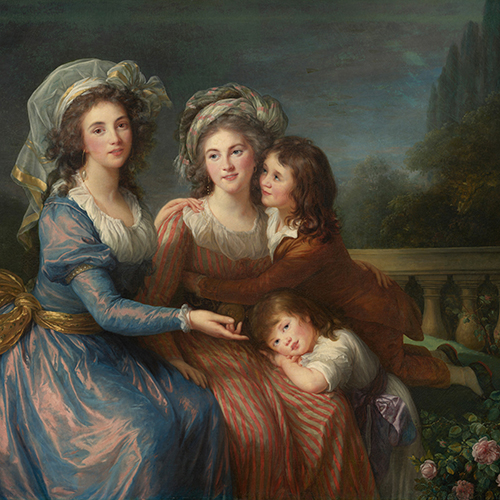
The Marquise de Pezay, and the Marquise de Rougé with Her Sons Alexis and Adrien by Élisabeth-Louise Vigée Le Brun, 1787
There have been successful professional women artists in the Western world since the time of the ancient Greeks. Yet many of their names were lost and their works misattributed for centuries—until the modern women’s movement sparked scholarly and popular interest in these remarkable individuals.
Today, myriad books, exhibitions, and an entire museum in Washington, D.C., focus on historical and contemporary women artists, and a few painters—Mary Cassatt, Georgia O’Keeffe, and Frida Kahlo—have reached the status of international icons.
But these modern superstars didn’t evolve within a vacuum: They descended from the centuries of celebrated artists who form the basis of art historian Nancy G. Heller’s wide-ranging examination. In richly illustrated programs she traces the history of European and American women artists from the late 16th century to 1950. She addresses the socioeconomic, political, and aesthetic significance of their work, placing the women’s lives and art within the context of their male contemporaries.
November 7 Women Artists Before, and During, the Italian Renaissance
Heller introduces the position of European women artists before the Renaissance and examines sumptuous royal portraits by the prominent 16th-century Italian painter Sofonisba Anguissola and technically accomplished sculpture by her countrywoman, Properzia de’ Rossi.
November 14 The Age of Grandeur: Baroque Art in Italy, Holland, and Spain
Explore high drama in the art and life of Italian Baroque painter Artemisia Gentileschi, noted for her shocking canvases depicting Biblical subjects from a woman’s point of view; the quieter, but no less profound, worlds created by Dutch genre painter Judith Leyster and flower-painting specialist Rachel Ruysch; and stunningly detailed religious sculptures by Spaniard Luisa Roldan.
November 21 French Rococo Art and Neoclassicism in Europe and America
Heller spotlights delicate, exquisite Rococo portraits by Queen Marie Antoinette’s favorite painter, Marie-Louise-Élisabeth Vigée Lebrun; moralizing tales from the hand of Neoclassicist Angelica Kauffmann; and the extraordinary life and work of Edmonia Lewis, a woman of African American and Native American ancestry raised on a Chippewa reservation who became a highly sought-after Neoclassical-style sculptor with prestigious patrons on both sides of the Atlantic.
December 5 19th-Century Romanticism, Impressionism, and More
Heller provides an overview of the enormous range of works produced by women during the 1800s, from the French painter Rosa Bonheur’s enormous canvas The Horse Fair to luminous scenes created by pioneering American Impressionist Mary Cassatt and her French counterpart, Berthe Morisot. She also considers Lilly Martin Spencer’s charming paintings of American home life and the powerful sculptures of August Rodin’s protégée, Camille Claudel.
December 12 Radical Experiments in the Early 20th Century
Heller surveys prominent women Surrealists, including Frida Kahlo and Meret Oppenheim and locates the art of Georgia O’Keeffe within its broader context of art history. She also focuses on a pair of exceptional individuals working in very different areas: Englishwoman Barbara Hepworth, known for “Single Form,” her monumental abstract sculpture outside the U.N. Secretariat building in New York City, and pioneering American architect Julia Morgan, who designed William Randolph Hearst’s celebrated castle in San Simeon, California.
Heller, a professor emerita at the University of the Arts in Philadelphia, is the author of Women Artists: An Illustrated History, currently in its fourth revised and expanded edition.
5 sessions (no class November 28)
World Art History Certificate core course: Earn 1 credit*
General Information
*Enrolled participants in the World Art History Certificate Program receive 1 core course credit. Not yet enrolled? Learn about the program, its benefits, and how to register here.